Stablecoin: Paradox of the blockchain world, is the USDT-led coin a grenade that will burst at any time?
Author: CoinEx Aladdin Global Ambassador
Editor's Note: The original title was "CoinEx Research Institute: The Paradox of the Blockchain World-" Stable Coin ""
Since Bitcoin was used as an innovative payment network and a new currency issue, decentralization, immutability, openness and transparency have been passed down as the core spirit of the blockchain. Even the public chains such as ETH and EOS, which later sought to expand, only sacrificed some decentralized features to improve performance. The stablecoin has become a direct abandonment of decentralization, which is different from the "Fed" in the world of blockchain.

- Exchange pushes Singapore into compliance
- Analysis of 3 smart contract architectures: Bank of England March Digital Fiat Report
- The true face of Zhongqingbao's blockchain: no business logic, the actual controller continues to reduce its holdings
Stablecoin that runs counter to the spirit of Bitcoin
The original loyalty of Bitcoin was currency circulation-an innovative payment network and a new type of currency. It adheres to a total of 21 million deflation, openness and decentralization.
Stable currency is stable circulation as fiat currency-severe inflation, centralization, and 1: 1 endorsement endorsement is opaque. Users who experienced a sharp drop in the USDT currency price on October 15, 2018, leading to "short positions and quilts" may be more experienced. Unfortunately, after this, not only did the issuance of stablecoins not decrease, but due to the increase in convenience of users, various forms of stablecoins emerged endlessly.
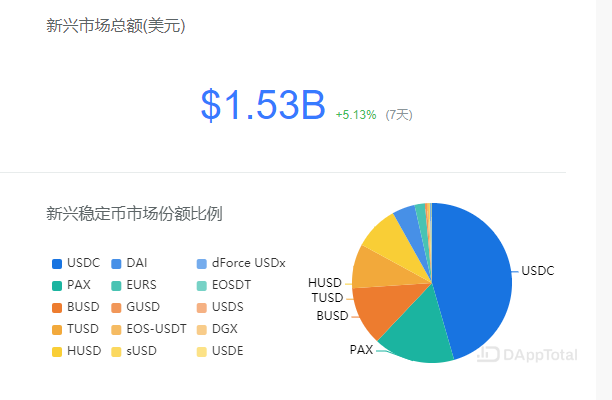
Data source: Dapptotal
Cottage's "Fed"
Stable coins are also essentially circulated as money. At present, the total market value is 7.66 billion U.S. dollars. Among them, centralized stable coins account for more than 90%. The centralized stablecoin has no guarantee, no endorsement and non-compliance stablecoin USDT has occupied nearly 80% of the market.
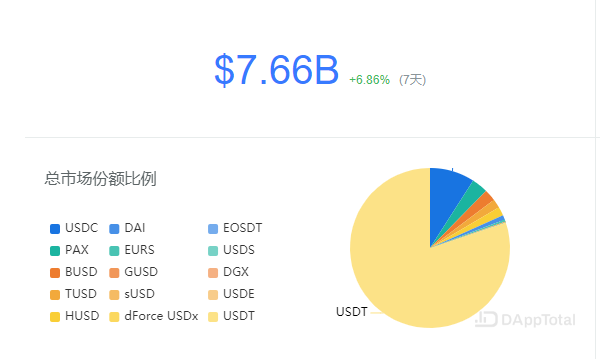
Data source: Dapptotal
Centralized stablecoins, in fact, play the functions of central banks in various countries, but do not have the ability to endorse them. Since the 3.12 plunge, its circulation has increased by 24.5%.
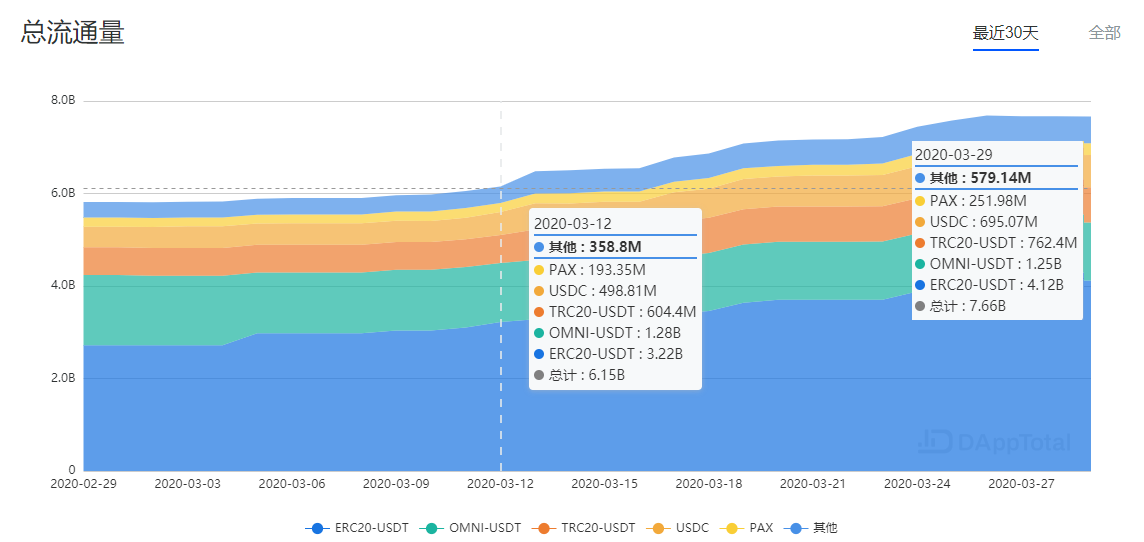
Data source: Dapptotal
This kind of "quantitative easing" is actually the exercise of the central bank's regulatory function in traditional financial markets. But they are not the same. In the traditional financial market, when the central bank releases liquidity, it needs to consider multiple factors, regulate the economy through a variety of currency instruments, and blindly issue currency. In the currency market, the issuance of such stablecoins led by USDT seems a bit arbitrary.
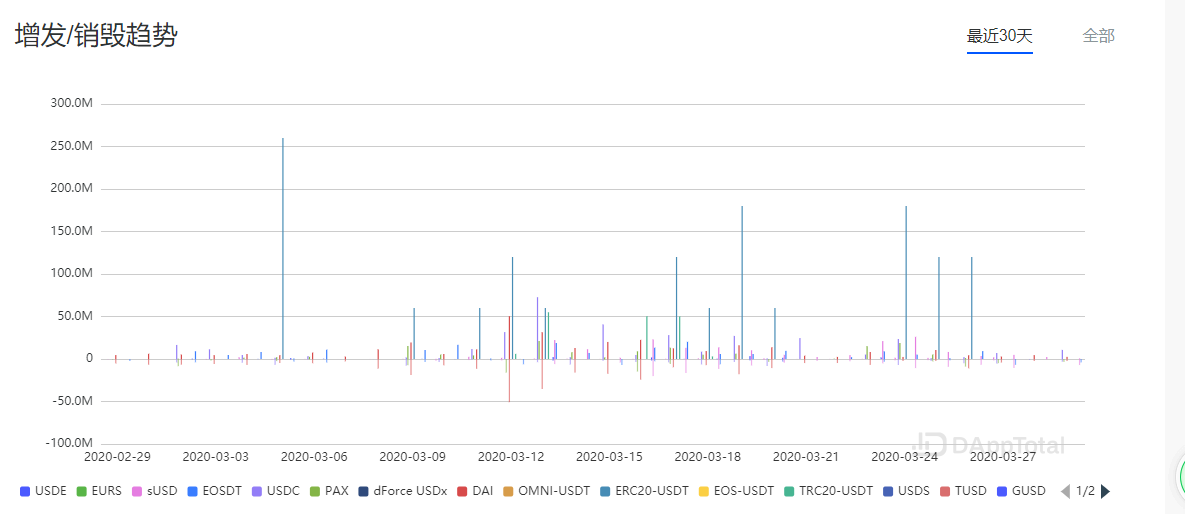
Data source: Dapptotal
Such wanton printing will only lead to price bubbles. There is no doubt that stablecoins are exercising powers beyond their capabilities. The Fed ’s November Financial Stability Report described one of the worst outcomes: Under such circumstances, once the stablecoin runs, the holders of the stablecoin will panic and they will demand the stablecoin. The issuer will return the fiat currency of the mortgage. And because there is no transparent and reliable US dollar reserve, the stablecoin led by USDT has become a grenade that will burst at any time.
USDT's huge market value and recognition
USDT has a market capitalization of USD 4 billion, ranking # 4, accounting for 3.47% of the USD 115 billion BTC market value.

Data source: Coingecko
Affected by the different policies of various countries on cryptocurrencies, many foreign countries can directly use the legal currency to deposit and withdraw funds. Fewer people use USDT, and more are domestic. However, the irony is that USDT does not have a clear case in the country like BTC to prove its legitimacy.
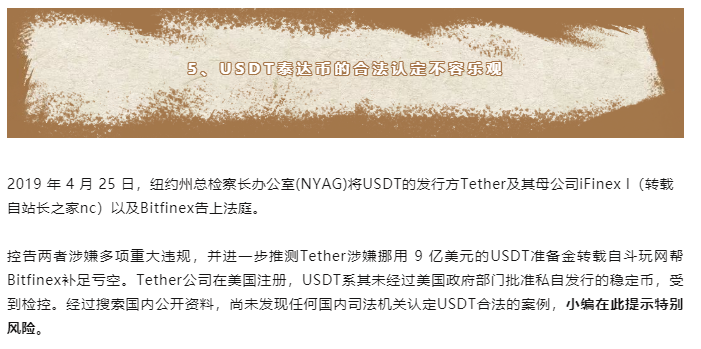
Data source: Aladdin CN
The awkward position of stablecoins
After the financial crisis in 2008, bitcoin emerged as a "digital gold" as an anti-fiat inflation. BTC's main counterparty should be all fiat assets. The stablecoin appeared after the BTC plunge in 18 years. So far, the main trading counterparties of the stablecoin are virtual currencies such as BTC and ETH. Among the various transaction pairs in the first quarter of 2020, USDT-ETH's transaction value accounts for 62% of all transaction value. The stablecoin has become a tool for speculation.
We will continue to update Blocking; if you have any questions or suggestions, please contact us!
Was this article helpful?
93 out of 132 found this helpful
Related articles
- Economist Lang Xianping talks about the blockchain industry under the epidemic: stripping of currency attributes, blockchain rebirth
- Academician of the Chinese Academy of Sciences: China's blockchain core technology is at risk
- Zhu Jiaming: "History will not 'fuse'"
- Analysis | Analysis of "Black Thursday" from the perspective of the order book, revealing the mechanism of the Bitcoin price collapse
- Viewpoint | VR is a once-in-a-year event, Blockchain is a once-in-a-year event
- Research PoW mining to find out: why crypto miners may become the new killer virus killer
- Bitcoin Liquid sidechain exceeds public Lightning Network channels in the number of BTC held






